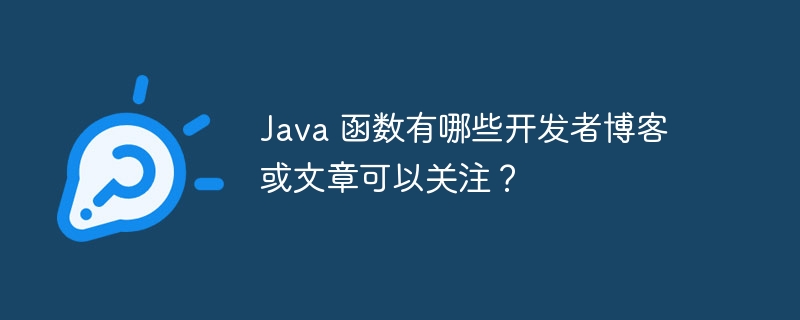What developer blogs or articles can I follow about Java functions?
Java Lambda functions, also known as Lambda expressions, make it possible to write more concise and readable code. They have two types: Lambda expressions, with a single expression that returns a value, and Lambda block declarations, which allow multiple lines of code in the function body. Practical examples: ordering a list, filtering a list and using a functional interface. Mastering Lambda functions allows developers to write more flexible and efficient code.

Dive into the depths of Java Lambda functions: a practical guide
Introduction
Java Lambda functions, also known as Lambda expressions, are a powerful tool that allows you to write more concise and readable code. In this article, we'll dive into the details of Lambda functions, explore their practical uses, and provide real-world examples to help you master this essential feature.
#Lambda Function Syntax
The general syntax of a Lambda function is:
(argumentos) -> expressão
where:
- arguments: The function's input parameters, separated by commas.
- expression: The body of the function, which contains the code to be executed.
Lambda Function Types
There are two main types of Lambda functions:
- Lambda Expressions: Contain only a single expression that returns a value.
- Lambda Block Declarations : Used when you need several lines of code in the function body.
Practical Examples
Let's explore some practical examples to demonstrate usage of Lambda functions:
1. Ordering a List
List<String> nomes = Arrays.asList("João", "Maria", "Pedro");
Collections.sort(nomes, (s1, s2) -> s1.compareTo(s2));2. Filtering a List
List<Integer> números = Arrays.asList(1, 2, 3, 4, 5, 6, 7, 8, 9, 10);
List<Integer> númerosPares = números.stream()
.filter(n -> n % 2 == 0)
.collect(Collectors.toList());3. Using a Functional Interface
interface Somador {
int soma(int a, int b);
}
Somador somador = (a, b) -> a + b;
int resultado = somador.soma(3, 5);Conclusion
Java Lambda functions are a valuable tool for writing more flexible and efficient code. By understanding their syntax and types and exploring real-world examples, you can make the most of the power of Lambda functions in your projects.
The above is the detailed content of What developer blogs or articles can I follow about Java functions?. For more information, please follow other related articles on the PHP Chinese website!

Hot AI Tools

Undresser.AI Undress
AI-powered app for creating realistic nude photos

AI Clothes Remover
Online AI tool for removing clothes from photos.

Undress AI Tool
Undress images for free

Clothoff.io
AI clothes remover

AI Hentai Generator
Generate AI Hentai for free.

Hot Article

Hot Tools

Notepad++7.3.1
Easy-to-use and free code editor

SublimeText3 Chinese version
Chinese version, very easy to use

Zend Studio 13.0.1
Powerful PHP integrated development environment

Dreamweaver CS6
Visual web development tools

SublimeText3 Mac version
God-level code editing software (SublimeText3)

Hot Topics
 Square Root in Java
Aug 30, 2024 pm 04:26 PM
Square Root in Java
Aug 30, 2024 pm 04:26 PM
Guide to Square Root in Java. Here we discuss how Square Root works in Java with example and its code implementation respectively.
 Perfect Number in Java
Aug 30, 2024 pm 04:28 PM
Perfect Number in Java
Aug 30, 2024 pm 04:28 PM
Guide to Perfect Number in Java. Here we discuss the Definition, How to check Perfect number in Java?, examples with code implementation.
 Random Number Generator in Java
Aug 30, 2024 pm 04:27 PM
Random Number Generator in Java
Aug 30, 2024 pm 04:27 PM
Guide to Random Number Generator in Java. Here we discuss Functions in Java with examples and two different Generators with ther examples.
 Weka in Java
Aug 30, 2024 pm 04:28 PM
Weka in Java
Aug 30, 2024 pm 04:28 PM
Guide to Weka in Java. Here we discuss the Introduction, how to use weka java, the type of platform, and advantages with examples.
 Armstrong Number in Java
Aug 30, 2024 pm 04:26 PM
Armstrong Number in Java
Aug 30, 2024 pm 04:26 PM
Guide to the Armstrong Number in Java. Here we discuss an introduction to Armstrong's number in java along with some of the code.
 Smith Number in Java
Aug 30, 2024 pm 04:28 PM
Smith Number in Java
Aug 30, 2024 pm 04:28 PM
Guide to Smith Number in Java. Here we discuss the Definition, How to check smith number in Java? example with code implementation.
 Java Spring Interview Questions
Aug 30, 2024 pm 04:29 PM
Java Spring Interview Questions
Aug 30, 2024 pm 04:29 PM
In this article, we have kept the most asked Java Spring Interview Questions with their detailed answers. So that you can crack the interview.
 Break or return from Java 8 stream forEach?
Feb 07, 2025 pm 12:09 PM
Break or return from Java 8 stream forEach?
Feb 07, 2025 pm 12:09 PM
Java 8 introduces the Stream API, providing a powerful and expressive way to process data collections. However, a common question when using Stream is: How to break or return from a forEach operation? Traditional loops allow for early interruption or return, but Stream's forEach method does not directly support this method. This article will explain the reasons and explore alternative methods for implementing premature termination in Stream processing systems. Further reading: Java Stream API improvements Understand Stream forEach The forEach method is a terminal operation that performs one operation on each element in the Stream. Its design intention is






